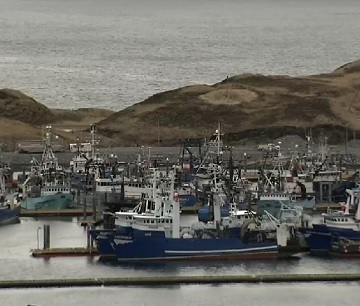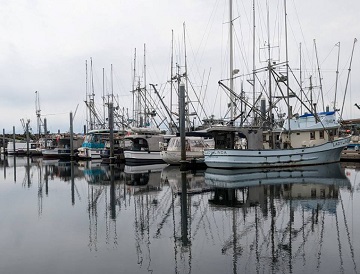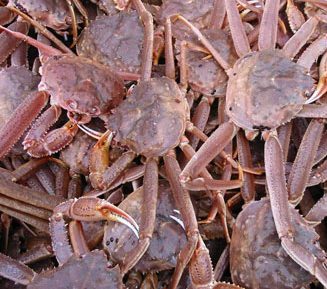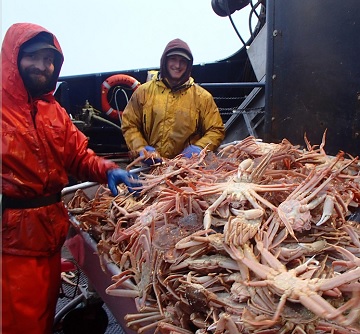Tag Archives: Alaska Department of Fish and Game

Bristol Bay red king crab fishery could return after two years on ice
The Alaska Department of Fish and Game is set to decide Friday whether or not to reopen the Bristol Bay red king crab fishery, which has been closed since 2021. Their decision will be based on recommendations from the North Pacific Fishery Management Council, which is meeting through Oct. 11 in Anchorage. During the Council’s meeting Tuesday, the Crab Plan Team presented data and analysis on Bristol Bay crab stocks from the summer trawl survey to the Scientific and Statistical Committee. Mike Litzow is a co-chair for the team and the shellfish assessment program manager and director at the National Oceanic and Atmospheric Administration’s Kodiak Lab. Litzow said while male and female crab are still at historic lows, the fishery is not at or approaching an “overfished” status. >>click to read<< 08:48

Commercial crab fishery closed for 2023-2024 season
The Alaska Department of Fish and Game has closed the commercial red and blue king crab fishery for the 2023-2024 season, the sixth year in a row, citing stock survey numbers that remain well below the regulatory threshold. The announcement made Wednesday is a blow to commercial fishers, who saw a significant drop in prices for chum (dog) and pink (humpback) salmon this year. “If they would open up the crab season for 10-15 days it would help bail us out of a terrible season,” said Norval Nelson, owner and operator of Star of the Sea, which was in Aurora Harbor. He made his comments before he learned of the news. >>click to read<<17:27
State opens commercial fishing on the Kuskokwim River to one person
 Coming just days after the U.S. Fish and Wildlife Service returned management of the Kuskokwim River to the Alaska Department of Fish and Game, the state has announced eight separate commercial openers in August. These opportunities are only available to individuals registered as catcher/sellers. On the Kuskokwim, there is only one of these and his name is Fran Reich. “I’ve been a commercial fisherman for almost 50 years on the river,” Reich said. Reich has been the sole catcher/seller on the river for around a decade. He said that he’s retired, but that fishing is just in his blood. He runs a small company called FAR West Fish & Farm out of his home in Bethel. >click to read< 13:50
Coming just days after the U.S. Fish and Wildlife Service returned management of the Kuskokwim River to the Alaska Department of Fish and Game, the state has announced eight separate commercial openers in August. These opportunities are only available to individuals registered as catcher/sellers. On the Kuskokwim, there is only one of these and his name is Fran Reich. “I’ve been a commercial fisherman for almost 50 years on the river,” Reich said. Reich has been the sole catcher/seller on the river for around a decade. He said that he’s retired, but that fishing is just in his blood. He runs a small company called FAR West Fish & Farm out of his home in Bethel. >click to read< 13:50

Fish plentiful, but fishermen scarce for Southeast Alaska’s first summer king opening
The numbers are in for the first opening in the summer troll fishery for king salmon in Southeast Alaska. The 12-day season saw more chinook landed than expected, despite fewer boats being on the water. Southeast trollers brought in about 85,000 king salmon from July 1 to July 12, around 8,000 fish over the target for the first opener of the season. At first, it might look like enthusiasm played a role, as it was only on June 21 that the US Ninth Circuit Court of Appeals issued a stay that allowed the fishery to occur at all. But that was not the case. Grant Hagerman manages the troll fishery for the Alaska Department of Fish and Game. He says even fewer trollers participated this summer than in 2022. >click to read< 10:37

Alaska salmon fishermen fume over low prices, but processors say they’re hurting too
Aboard the F/V Five Star, his boat, Danielson and his deckhand put away as many pounds of fish as they could. They had no breakdowns. But his seafood processor is paying him 70 cents per pound for his salmon, half of last year’s price which means that instead of his usual six-figure haul for a summer of hard work, he might only break even, or go home to his family in Washington with $10,000, if he’s lucky. He added: “We’re up against something that’s out of our control, and that’s the processors killing us here.” In the past few weeks, thousands of fishermen across the state have found themselves in a similar predicament,,, Photos, >click to read< 08:52

Western Alaska: Crab are looking healthy after downturn in 2019
The region is known for its abundant crab populations and supports several species. Ten species of crab are caught throughout fisheries in the state, seven of them having commercial importance. According to the Alaska Fish and Game (ADF&G) website, the Bering Sea, Aleutian Islands, and the Gulf of Alaska combined produce approximately 1/3 or more of total crab catches in the United States. The season for commercial crabbing is dependent on when they open, and how fast the guideline harvest limit (GHL) is caught. The harvest data from this season and the trawl survey are put into the model. >click to read< 12:57

Bristol Bay bust – Bristol Bay salmon prices hit rock bottom
Prices paid commercial fishermen for their catches of wild, Bristol Bay sockeye salmon have just set a modern record low of 50 cents per pound. That’s only three cents per pound less than the average price paid for a Southeast Alaska pink salmon – or humpy as Alaskans usually call the smallest and blandest tasting of the Pacific – in 2018, according to Alaska Department of Fish and Game data. With a correction for inflation, that old humpy would now be worth 8 cents more per pound than a Bristol Bay sockeye. The last time the Bay saw anything like this was more than two decades ago when the sockeye price hit 42 cents per pound. Once inflation adjusted, however, those fish had a value of 70 cents per pound – 20 cents more than what Trident Seafoods and other processors are now offering. >click to read< 07:53

What salmon eat in the open ocean
After one to two years of munching on zooplankton in freshwater, young sockeye – or smolt – head for salt water to begin the next chapter of their anadromous lives, where there’s a whole different menu available. Dr. Katie Howard studies salmon diets in the open ocean and is an ocean fisheries scientist with the Alaska Department of Fish and Game. “The sockeye, pink and chum, eat a pretty diverse array of invertebrates and fish,” she said. “And the amount that their diets overlap or don’t overlap, is really dependent on where they are.” Howard calls these three species of salmon generalists; for the most part, they’ll eat whatever is available to them. But she says chinook, or king salmon, choose different marine meals. “Chinook tend to focus more on fish and squid. But, which fish and which squid really depends on where they are and what’s available,” she said. >click to read< 11:08

Crab season closures ‘devastating’ for Bering Sea fishing family
For Kodiak’s Gabriel Prout, crab fishing is both an occupation and a way of life. “There’s something special about being on the water and being a Bering Sea crab fisherman,” said Prout, whose father spent 45 years fishing on the Bering Sea. “It’s kind of hard to explain. There is a deep appreciation for what we do and the resource and the job and the work we put in.” In the summer of 2020, Prout and his brothers purchased a boat and took out loans to buy fishing rights. But in the fall of 2022, his family was hit with multiple setbacks. Not only had the Alaska Department of Fish and Game canceled the Bristol Bay red king crab season for the second year in a row, the Bering Sea snow crab season was also canceled. Video, >click to read< 14:04

Statewide commercial salmon harvest tops 14M fish
Millions of wild salmon heading for their spawning grounds in Alaska are being greeted by commercial fishermen with drift gillnets and setnets, harvesting upwards of 14 million fish through Tuesday morning, including over four million in Prince William Sound. For the Copper River District itself over 601,000 salmon were delivered to processors and the state’s central region had an overall catch of over 11.6 million fish. Preliminary data compiled by the Alaska Department of Fish and Game put the catch through Tuesday at over 14 million fish harvested statewide, including 10.3 million sockeyes, 3.3 million chums, 331,000 pink, 46,000 Chinook, and 6,000 coho salmon. >click to read< 10:54

Chinook troll fishers in Southeast Alaska to put hooks in water July 1, but how many can they catch?
One day after the Ninth Circuit Court of Appeals overturned a Seattle judge’s ruling that had shut down the Southeast Alaska chinook troll fishery, the Alaska Department of Fish and Game delivered the catch limit news to the troll fishermen, specifying the number of kings they are allowed to catch during the upcoming season. Commercial trollers will have a total allocation of 74,800 chinook salmon during the first retention period, which begins July 1. Based on data from past years, the department thinks that the goal will be reached in 9-10 days, depending on weather. >click to read< 09:35

Crab pots ‘absolutely stuffed’ as Bering Sea Dungeness fishery breaks records
While many Bering Sea crab populations are in freefall, Dungeness crab is breaking records in regions that hardly used to see them. The North Peninsula District in the eastern Bering Sea opened as a commercial Dungeness fishery in the early ‘90s. In those early days, it was common for just one or two boats to fish there — many seasons, there were none. The numbers increased modestly over the ensuing decades — but that growth has recently become exponential. “The pots that we’re seeing coming out of this fishery are absolutely stuffed with crab,” said Ethan Nichols, who works for the Alaska Department of Fish and Game. “Like, you don’t even know how many crabs can fit in a pot.” >click to read< 20:43

ADF&G discusses where to spend disaster funding for crabbing fisheries
The Alaska Department of Fish and Game hosted a second meeting to discuss how to distribute funds to fisheries that experienced disaster in recent years, with Thursday’s meeting focusing on Bristol Bay red king crab and Bering Sea snow crab fisheries. Much of the discussion centered around the division of payments between the vessel and crew members, with several people calling for 60% to go to the vessel and 40% to the crew, rather than a 70/30 split. “The boat I’m on and have been on for many years, we’re the same on any crab fishery — it’s always 60 to the boat and 40 to the humans,” fisherman Mike Mathisen said. Video, >click to read< 13:40

‘It’ll be a disaster’: Southeast Alaska fishermen fear looming closure of king salmon fishery
“I’m optimistic, but I’m also scared as heck,” said Eric Jordan, a lifelong fisherman and resident of trolling stronghold Sitka at the standing room-only meeting with federal National Marine Fisheries Service officials. The closure of the king salmon fishery in Southeast Alaska would be economically devastating, according to many in the region who rely on the valuable fish for their annual income. A federal judge in Washington state effectively shut down the fishery in May in response to a lawsuit brought by Wild Fish Conservancy, a Washington organization. The suit contends that the fishery should be closed to protect endangered killer whales in Puget Sound that feed on chinook salmon. >click to read< 11:46

Commercial shrimpers adjusting to new spring fishing season
Three commercial pot shrimp fishery areas near Ketchikan are closed or set to close as fishermen approach area-specific spot shrimp harvest limits about two weeks after the fishery opened May 15. Fishermen targeting spot shrimp with pot gear this month are testing new waters after the Board of Fisheries during its 2022 rule-setting process voted to change the pot shrimp season start date from Oct. 1 to May 15; the fishery had occurred during fall and winter months since the mid-1900s. “It changed some of the players slightly, some of the people that typically fish in October are unavailable in the spring,” Meredith said. “You’ve got some new people on the grounds that weren’t available to do it in October that are now participating in May.” Meredith said that most of the fishermen who have been long-time pot shrimp fishermen “expected it to be a little different.” >click to read< 11:38

These are Alaska’s priorities for fishery management council
Based on discussions with a diverse range of user groups, delegations from our coastal communities, fishermen, processor representatives and other Alaskans, it is clear our fisheries are facing a number of challenges. These challenges include unprecedented declines in Bering Sea crab stocks and ongoing low harvestable levels of Pacific cod and other economically valuable stocks that are causing economic hardship for fishery participants and affected communities. We also heard ongoing concerns about the impacts of federal fisheries on key species like halibut, salmon, and crab. This input was valuable to better understand the issues and to identify priorities and potential solutions. >click to read< 16:01

Record-low quota caught as Bering Sea Tanner crab season wraps up
The fishing season has ended for Bering Sea Tanner crab. Crabbers caught the record-low quota of two million pounds just before the end of March. Seventeen vessels went out for tanner across the fishery’s east and west districts, said Ethan Nichols, the assistant area management biologist with the Alaska Department of Fish and Game in Unalaska. “Some boats caught their quota in the fall. Some caught it in the spring,” said Nichols. “Overall, the fishery performance was pretty good. ”Vessels were targeting and retaining crabs that were smaller than the industry-preferred size of five inches, but still perfectly legal to retain,” said Nichols. “And that was somewhat to make up for the lack of snow crab coming out of the Bering Sea.” >click to read< 11:29

Alaska officials prepare for possible commercial fishing expansion into Arctic waters
Bans on commercial fishing in U.S. and international Arctic waters have been lauded as admirable preemptive actions that protect vulnerable resources before they are damaged by exploitation. But now the Alaska Department of Fish and Game is preparing for a time when the 14-year-old moratorium on commercial fishing in federal Arctic waters is lifted. The department is seeking $1 million in state general funds and another $2 million in federal funds to work on research to better understand those Arctic waters in the event that commercial fisheries are conducted there, Fish and Game Commissioner Doug Vincent-Lang said on Wednesday. >click to read< 12:42

No commercial Togiak sac roe herring fishery this spring, after years of a shrinking market
Fish processors have indicated they will not buy Togiak herring this season, according to the Alaska Department of Fish and Game’s outlook released March 20. It’s the first time there hasn’t been a commercial fishery there in decades. That means that this spring, over 57,400 tons of herring will go unharvested. But as the market has declined, so has the price for herring. Tim Sands, said they’ve seen an especially sharp decline in interest since the COVID-19 pandemic began three years ago. The size of the commercial fleet in Togiak has shrunk as well. It used to comprise hundreds of vessels. But last year no gill netters fished, and just eight purse seine vessels participated, hauling in less than a quarter of the available harvest. Togiak herring, meanwhile, are doing just fine. >click to read< 13:50

Herring fishery to go on two-hour notice Thursday
The Sitka Sound Sac Roe herring fishery will go on two-hour notice on Thursday morning (3-23-23). That means at any time after that, the Alaska Department of Fish and Game can announce a fishery opening with two hours warning. Last year, the guideline harvest level for the fishery was 45,000 tons, but fishermen only caught around 25,000. That was still the highest harvest on record. The guideline harvest level for this year’s fishery is set at 30,000 tons. >click to read< 13:58

Solutions to the Bycatch Blame Game
The issue of bycatch has grown more important as some fisheries get smaller and those who depend on the fish for their livelihood or survival find that there are not enough fish to go around. This raises the question of whether bycatch is at the root of the problem or if other issues facing fisheries must be addressed. Bycatch is monitored in a combination of ways, through at-sea observers, electronic monitoring, seafood processing plant observers, logbooks, and fish tickets. “In the Bering Sea, approximately 94 percent of all catch is observed, including 99 percent of all trawl catch,” Bush explains. “In the Gulf of Alaska, 40 to 50 percent of all catch is observed across all gear types.” Photos, >click to read< 12:26

Months before season begins, state closes most Cook Inlet king salmon fishing
Parts of the Kenai River are still frozen over. But the Alaska Department of Fish and Game has already closed the early and late king salmon runs to sport fishing — also shutting down the beleaguered Cook Inlet east side set-net fishery before fishermen can gear up. “This is my 53rd year coming up as a set-netter, and I have never experienced this,” said Ken Coleman, vice president of the Kenai Peninsula Fishermen’s Association. He said he’s never seen the fishery close completely this early. Fish and Game does release a preseason forecast for the early king salmon run every winter, to give guides and fishermen a sense of what to expect before the summer starts. >click to read< 15:09

Urgent research to be undertaken on Bristol Bay Red King Crab
Urgent crab research will be getting underway in mid-March thanks to funds provided by both Alaska Department of Fish and Game and NOAA Fisheries, according to reports from Alaska Bering Sea Crabbers. The research is expected to use two chartered crab vessels with three scientists each, plus crew, to conduct research on Bristol Bay red king crab, including a pot survey, tagging, and gear studies. It will span roughly 25 days and begin in mid-March. The survey will set out to accomplish three main goals that may help inform management decisions in the future and will lay out important groundwork for future studies, >click to read< 08:31

After a highly anticipated start, Kodiak’s Tanner crab season is almost over
Kodiak’s Tanner crab fleet spent the first two weeks of the season tied up at the docks, awaiting better prices from local seafood processors. And after a highly anticipated opener just over a week ago on Jan. 30, the season is nearly over; most of the fishery had closed by the end of the weekend. Fisherman Eddie Perez was selling Tanners from his boat, the F/V Vero Victoria, on Monday morning. He had about 500 crabs on board when he pulled up to the dock – and he expected to sell out by noon. “Everybody’s been really excited, happy that local fishermen are offering to the community and it’s been going really good,” said Perez. >click to read< 15:53

Council has 4 months to fix Cook Inlet salmon fishery management plan
The future of the Cook Inlet salmon fishery is again in the air as the North Pacific Fishery Management Council debates how to manage it after a federal court ruled that it has to write a new plan. It’s been six years since a federal court ruled that the council’s decision to remove Cook Inlet from a federal management plan and defer entirely to the state was illegal. The council initially decided to remove Cook Inlet in 2012, a decision that the United Cook Inlet Drift Association challenged in court. In 2016, the court agreed with the association, ordering the council to create a new federal management plan that includes the federal waters of Cook Inlet. >click to read< 09:47

Alaska crab fishery collapse seen as warning about Bering Sea transformation
Less than five years ago, prospects appeared bright for Bering Sea crab fishers. Stocks were abundant and healthy, federal biologists said, and prices were near all-time highs. Now two dominant crab harvests have been canceled for lack of fish. For the first time, the Alaska Department of Fish and Game in October canceled the 2022-2023 harvest of Bering Sea snow crab, and it also announced the second consecutive year of closure for another important harvest, that of Bristol Bay red king crab. What has happened between then and now? A sustained marine heat wave that prevented ice formation in the Bering Sea for two winters, thus vastly altering ocean conditions and fish health. “We lost billions of snow crab in a matter of months,”,,, >click to read< 18:54

New study proposes to uncover where chinook salmon could be dying en route to Yukon
The state of Alaska is proposing new research to track dwindling chinook salmon numbers this spring, and it’s possible the study could eventually extend into the Yukon. This week, members of the bilateral Yukon River Panel met in Anchorage, Alaska, to brainstorm ways to help the salmon, which undertake one of the longest salmon migrations in the world. It’s during this migration, though, that tens of thousands of salmon seem to go missing every year. >click to read< 10:23

St. Paul government declares emergency in attempt to get ahead of looming crab crash
The Pribilof Island of St. Paul runs on snow crab — also known as opilio crab. The community’s Trident Seafoods is one of the largest crab processing plants in the world. So when fisheries management officials announced the species “overfished” and the Alaska Department of Fish and Game shut down snow crab for the first time in the fishery’s history in October, City Manager Phillip Zavadil knew the community needed to act fast. “We’re trying to get creative and have people understand that this is going to happen more and more, and that we need to address it,” Zavadil said. “We can do something now, instead of waiting for next year, when we don’t have any funding or we can’t provide services.” About two weeks after ADF&G’s closure announcement, the city declared a cultural, economic and social emergency. >click to read< 10:51

Canceled crab season could devastate Unalaska
As the top fishing port by volume in the nation, fishing runs in the veins of Unalaska. Officials say that nearly everyone in the city relies on the robust seafood industry. “Our only industry is our fishing industry. So everything that goes on in communities are related,” said Frank Kelty, the Fishery consultant for the City of Unalaska. “In 2019, we had the quota of 45 million pounds. Then last year, we were down to 25 million pounds,” Kelty said. This year, that industry came to a drastic halt. “You know 60, 70 boats not buying fuel. Not buying groceries. It adds up pretty quick,” Kelty said. “Those boats aren’t fishing, they are not buying groceries every five days when they come in for a trip, Video, >click to read< 13:42














































